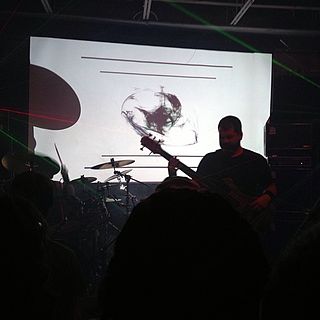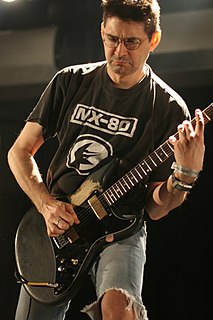Funk is a music genre that originated in African-American communities in the mid-1960s when African-American musicians created a rhythmic, danceable new form of music through a mixture of soul music, jazz, and rhythm and blues (R&B). Funk de-emphasizes melody and chord progressions and focuses on a strong rhythmic groove of a bass line played by an electric bassist and a drum part played by a drummer, often at slower tempos than other popular music. Like much of African-inspired music, funk typically consists of a complex groove with rhythm instruments playing interlocking grooves that created a "hypnotic" and "danceable feel". Funk uses the same richly colored extended chords found in bebop jazz, such as minor chords with added sevenths and elevenths, or dominant seventh chords with altered ninths and thirteenths.
Heavy metal is a genre of rock music that developed in the late 1960s and early 1970s, largely in the United Kingdom. With roots in blues rock, psychedelic rock, and acid rock, the bands that created heavy metal developed a thick, massive sound, characterized by highly amplified distortion, extended guitar solos, emphatic beats, and overall loudness. The genre's lyrics and performance styles are sometimes associated with aggression and machismo.

In music performances, rhythm guitar is a technique and role that performs a combination of two functions: to provide all or part of the rhythmic pulse in conjunction with other instruments from the rhythm section ; and to provide all or part of the harmony, i.e. the chords from a song's chord progression, where a chord is a group of notes played together. Therefore, the basic technique of rhythm guitar is to hold down a series of chords with the fretting hand while strumming or fingerpicking rhythmically with the other hand. More developed rhythm techniques include arpeggios, damping, riffs, chord solos, and complex strums.
The time signature is a notational convention used in Western musical notation to specify how many beats (pulses) are contained in each measure (bar), and which note value is equivalent to a beat.

The ride cymbal is a standard cymbal in most drum kits. It maintains a steady rhythmic pattern, sometimes called a ride pattern, rather than the accent of a crash. It is normally placed on the extreme right of a drum set, above the floor tom.
Progressive metal is a fusion genre melding heavy metal and progressive rock that combines the loud "aggression" and amplified guitar-driven sound of the former with the more experimental, cerebral or "pseudo-classical" compositions of the latter.

In music, groove is the sense of propulsive rhythmic "feel" or sense of "swing". In jazz, it can be felt as a persistently repeated pattern. It can be created by the interaction of the music played by a band's rhythm section. Groove is a significant feature of popular music, and can be found in many genres, including salsa, funk, rock, fusion, and soul.
A number of heavy metal genres have developed since the emergence of heavy metal during the late 1960s and early 1970s. At times heavy metal genres may overlap or are difficult to distinguish, but they can be identified by a number of traits. They may differ in terms of: instrumentation, tempo, song structure, vocal style, lyrics, guitar playing style, drumming style, and so on.
In the history of European art music, the common practice period is the era between the formation and the decline of the tonal system. Though there are no exact dates for this phenomenon, most features of the common-practice period persisted from the mid- to late baroque period, through the Classical, Romantic and Impressionist periods, or roughly from around 1650 to 1900. While certain prevailing patterns and conventions characterize the music of this period, the time period also saw considerable stylistic evolution. Some conventions evolved during this period that were rarely employed at other times during what may still be labeled "common practice". Thus, the dates 1650–1900 are necessarily nebulous and arbitrary borders that depend on context. The most important unifying feature through this time period concerns a harmonic language to which modern music theorists can apply Roman numeral analysis.
Lead guitar is a musical part for a guitar in which the guitarist plays melody lines, instrumental fill passages, guitar solos, and occasionally, some riffs within a song structure. The lead is the featured guitar, which usually plays single-note-based lines or double-stops.
In rock, heavy metal, blues, jazz, punk, fusion, some pop, and other music styles, lead guitar lines are usually supported by a second guitarist who plays rhythm guitar, which consists of accompaniment chords and riffs.
Duple metre is a musical metre characterized by a primary division of 2 beats to the bar, usually indicated by 2 and multiples (simple) or 6 and multiples (compound) in the upper figure of the time signature, with 2
2, 2
4, and 6
8 being the most common examples.

A rhythm section is a group of musicians within a music ensemble or band who provide the underlying rhythm, harmony and pulse of the accompaniment, providing a rhythmic and harmonic reference and "beat" for the rest of the band.

Intronaut is a progressive metal band from Los Angeles, California that incorporates complex polyrhythms, progressive rock, and jazz. Intronaut features former members of Anubis Rising, Exhumed, Uphill Battle, and Impaled.
In popular music, a fill is a short musical passage, riff, or rhythmic sound which helps to sustain the listener's attention during a break between the phrases of a melody. "The terms riff and fill are sometimes used interchangeably by musicians, but [while] the term riff usually refers to an exact musical phrase repeated throughout a song", a fill is an improvised phrase played during a section where nothing else is happening in the music. While riffs are repeated, fills tend to be varied over the course of a song. For example, a drummer may fill in the end of one phrase with a sixteenth note hi-hat pattern, and then fill in the end of the next phrase with a snare drum figure.
Triple metre is a musical metre characterized by a primary division of 3 beats to the bar, usually indicated by 3 (simple) or 9 (compound) in the upper figure of the time signature, with 3
4, 3
2, 3
8 and 9
8 being the most common examples. The upper figure being divisible by three does not of itself indicate triple metre; for example, a time signature of 6
8 usually indicates compound duple metre, and similarly 12
8 usually indicates compound quadruple metre.

In popular music, half-time is a type of meter and tempo that alters the rhythmic feel by essentially doubling the tempo resolution or metric division/level in comparison to common-time. Thus 4
4 approximates 8
8. It is not to be confused with alla breve or odd time. Though notes usually get the same value relative to the tempo, the way the beats are divided is altered. While much music typically has a backbeat on quarter note (crotchet) beats two and four, half time would increase the interval between backbeats to double, thus making it hit on beats three and seven, or the third beat of each measure :
1 2 3 4 1 2 3 4
1 2 3 4 5 6 7 8
1 2 3 4

Jazz drumming is the art of playing percussion in jazz styles ranging from 1910s-style Dixieland jazz to 1970s-era jazz fusion and 1980s-era Latin jazz. The techniques and instrumentation of this type of performance have evolved over several periods, influenced by jazz at large and the individual drummers within it. Stylistically, this aspect of performance was shaped by its starting place, New Orleans, as well as numerous other regions of the world, including other parts of the United States, the Caribbean, and Africa.
In music, the term swing has two main uses. Colloquially, it is used to describe the sense of propulsive rhythmic "feel" or "groove" created by the musical interaction between the performers, especially when the music creates a "visceral response" such as feet-tapping or head-nodding. The term is also used more specifically, to refer to a technique that involves alternately lengthening and shortening the pulse-divisions in a rhythm.

Heavy metal drumming is a style of rock music drum kit playing that developed in the late 1960s and early 1970s, largely in the United Kingdom and the United States. With roots in blues rock and psychedelic/acid rock drum playing, heavy metal drummers play with emphatic beats, and overall loudness using an aggressive performing style. Heavy metal drumming is traditionally characterized by emphatic rhythms and dense bass guitar-and-drum sound. The essence of metal drumming is creating a loud, constant beat for the band using the "trifecta of speed, power, and precision".








